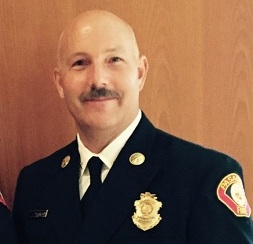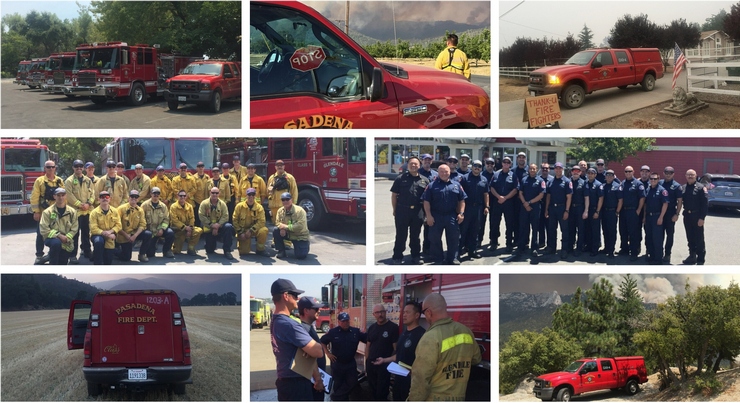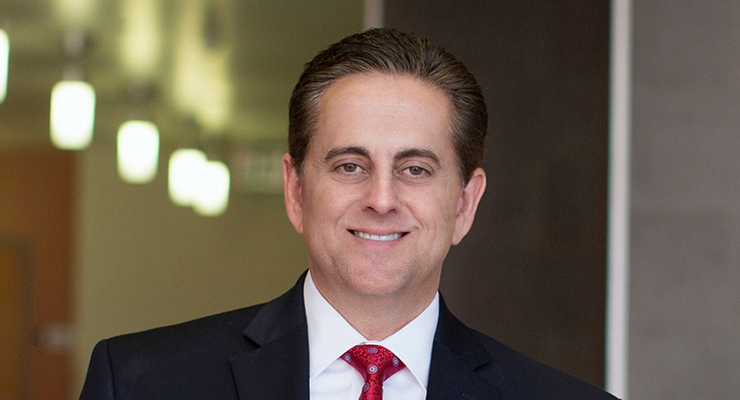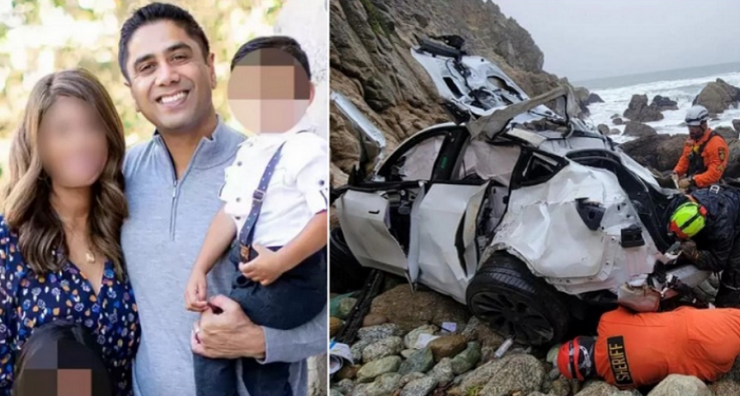[smooth=id:1442;]
[Updated] A strike team of 22 firefighters commanded by Pasadena Battalion Chief Anthony Bagan on Thursday returned safely from 15 days of deployment to the firefights battling the Cranston fire in Idyllwild and the massive Mendocino complex fires.
The team was dispatched on July 26, just a day after the Idyllwild fire erupted.
As of Thursday morning, that fire had charred more than 13,000 acres in the San Bernardino National Forest, with a total of 160 fire personnel committed to the fire response, including the team lead by Battalion Chief Bagan.
Bagan said the Glendale, Burbank and Alhambra firefighters under his command spent three days at the Idyllwild fire helping with structure defense – which means defending existing homes and buildings in the area from catching fire – and then were released only to be immediately reassigned to the Mendocino complex fire in Lake County.

The team spent about 10 days at the Mendocino complex blazes, which have now scorched 300,000 acres and are, combined, officially the largest-ever California fire.
“The way it works when strike teams get dispatched is there’s a minimum commitment of seven days, but it can be extended depending on the fires,” Bagan said. “So we were extended 14 days and that’s why we went from one fire [to] directly getting reassigned to another fire.”
The strike team which Bagan commanded was composed of 22 personnel, equivalent to five engine companies in the fire department organization. The team included a trainee whom Bagan is coaching to become a strike team leader.
The deployment left a temporary vacancy in battalion chiefs in Pasadena, but other chiefs covered the gap by putting in overtime work, Bagan said.
Coincidentally, Pasadena experienced an unusually large number of structure and vegetation fires during the two weeks during which the strike team was away. On August 1, a spectacular two-alarm blaze virtually destroyed a historic 131-year-old Victorian home in northwest Pasadena, and on August 3 another two-alarm house fire killed four dogs and a cat.
Bagan said the operating environment in the firefights was dangerous and oppressive. Temperatures lingered in the triple digits, and humidity was high.
“Our primary mission being dispatched up there was structure defense. That’s the typical mission of Type 1 engines, and that’s what we were assigned on for all of the operational periods,” he said. “We did do some mop up, which is going out onto the fire line into the grass and mopping, making sure it doesn’t rekindle and start spreading when the wind kicks up.”
The team’s Mendocino complex assignment took them first to the Upper Lake County and then to the city of Lucerne and finally to Spring Valley.
“The first thing we do is we triage the structures,” Bagan said. “Obviously that’s an area we’re not used to. We don’t know it like our own backyard. So we get assigned that geographical area, a street or a section of the city as a strike team, and our team will go out and do triage on the structures and see what structures are clearly save-able, which ones are indefensible and which ones are standalone.”
The team had to clear a lot of brush as the fire was moving near homes, clear piles of wood and combustible material away from structures, climb trees and cut down branches, and climb roofs and clean them of dry leaves and debris.
“If we’re still there when the fire gets comes through, we defend the structures and we use the water in our tanks to extinguish small grass fire as it spreads and gets closer to the structure,” Bagan said. “Sometimes our tactic is to prep the structure, then move out of the way and let the fire burn past, and then we come back in and extinguish anything that’s burning. It really depends on the fuel type and the behavior of the fire and what the fire’s doing at the time that it comes through that area.”
At other times during the deployment, Bagan said the team also had to dialogue with homeowners and other community members helping in the fire response, to educate them about how to fire-proof their homes.
“It’s critical that the residents themselves do their part before a fire starts to create their own defensible space and give us a chance to defend their structures,” he said. “If residents don’t do anything to create defensible space around their structure, we don’t have the time or the resources to do that for them before the fire gets there.”
“Sometimes we can go into an area and triage and prep the structures and maybe we have a day or two before the fire is going to get there. Sometimes we may only have five or 10 minutes. The fire’s bearing down, the wind blowing it and pushing it, and we get in there right at the last minute and there’s just nothing we can do for some of the structures.”
The team’s assignment to the Idyllwild and Mendocino fires is characteristic of the California Fire and Rescue Mutual Aid System. Hard-pressed jurisdictions elsewhere ask for strike teams from another area to assist when their resources are exhausted.
The team was dispatched in the morning of July 25 and came to be called 1203 Alpha when it reached Idyllwild.
At that time, Pasadena did not have the resources to commit a fire engine for immediate deployment, so the team called up two engines from the city of Glendale, two from Burbank, and one from Alhambra, making up five Type 1 engines for the strike team.
Bagan said they worked with strike teams from other jurisdictions in Los Angeles County. Some of those other teams were also allowed home at the same time as the Pasadena team.
Asked how the current fires compared with last year’s, Bagan said more wildfires have occurred in larger areas this season compared to any other time in California.
“And we’re not even halfway through the season,” he said. “I’ve been in the fire service for 30 years and the first five years of my career, we maybe went out on one or two strike teams a year. This is my fourth strike team, and like I said, we’re just in the middle of the season right now.
Bagan said he is seeing what he calls a definite change in fire behavior and the sheer number of fires.
“A lot of that has to do with the drought and the fuel moisture and the climate,” he said.
He said another factor may be the fact that more and more people are building residences closer to the edge of forested areas, or what he calls the wildland-urban interface.
“When we start getting the structures intermingled with the brush and the wildland, that’s what makes it really challenging for us because our number one priority is to protect people, to protect life, followed by protecting property,” Bagan said. “So we find ourselves in these situations of defending these structures because they are built in the wildland interface.”

















